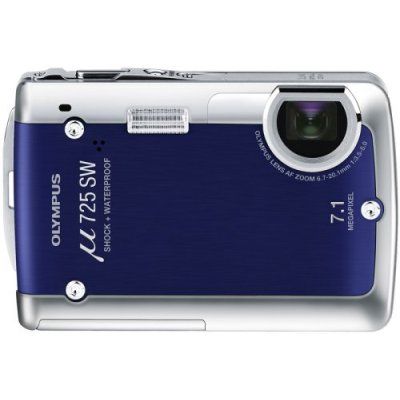About 2 weeks ago I finished the test of Ricoh’s 500G Wide, a ruggedised digital compact; it espoused design finesse for practicality and provided a great package as a family snapper the kids could use and yet remain the workman’s tool it is designed to be.
Our quick take
The Olympus Mju 725SW might look a little pricey at £300 given its 7.1-megapixel resolution, but you’re getting an armour plated, Tonka-tough take anywhere camera built for any outdoor activity from snorkeling or skiing to rock climbing or hiking in torrential rain.
Add to that images that hold plenty of detail (making A3+ prints a real possibility) and its easy to use controls and while it may lack manual control options, it makes it almost the perfect photo partner for those needing a simple snapper for more demanding environments.

Olympus Mju 725SW digital camera - 4.5 / 5
| FOR | AGAINST |
|---|---|
|
|
Enter the armour-plated Mju 725, Olympus’ latest ruggedised camera, one that could not be more different. A stylish all metal bodied beauty that is small enough to slip into a shirt pocket yet tough enough to take almost anywhere.
Waterproofed to a depth of 5 metres (about 15-feet) and shock-proofed for drops from 1.5-metres (around 5 feet) and supplied with a neat Velcro (outdoor) carry anywhere case, including a karabiner to lock it to a belt or harness. The case works well despite the camera looking a tad exposed on my arm on a run; it did not budge from its case.
The camera comes with a very bright and clear 2.5-inch colour screen, a 3x optical zoom lens giving a 38-114mm focal length range and modest maximum apertures of F/3.5 to F/5. There are 25 scene modes that provide a good range of automatic shooting options including portrait and landscape modes, sports and a candle plus a few less ordinary options such as a cuisine mode. The movie mode provides 640 x 480-pixel resolution clips with audio to the limit of the storage in use, but at a disappointing 15fps maximum.
You also get four underwater settings that provide a range of options including two wide-angle modes (one for landscapes and one for “action” shots, one for underwater macro shooting and an underwater snapshot setting where the focus is fixed.
A tiny rechargeable battery sits underneath a small but again, metal flap on the base of the camera that despite its small size provided enough power for around 100 shots in very cold conditions, around 40 shots at a party with around 50% flash and then about 2 hours printing connected to a portable printer dock via its USB connection.
Next to the battery sits the storage of choice; xD-PictureCard (there’s a modest internal memory as well, just enough for only five top quality shots) while the aforementioned USB port is housed beneath a (metal) flap on the camera’s side. A periscope-style lens sits beneath a metal, slide away cover (so does not protrude from the body when you zoom) with a small underpowered flash unit. Other controls include the top plate shutter release set beneath two sculpted bumps so it is easy to feel when using gloves. A small on/off button is recessed to prevent accidental usage.
On the back, alongside that excellent screen are the remaining controls that include overly small zoom buttons, a Scene mode button that also switches to the Program mode and the 725’s image stabilisation mode. The latter is not however an active system (lens or sensor) but uses a high ISO 1600 setting to make available higher shutter speeds to freeze and possible blur.
However, this tactic works at the expense of image noise, which is noticeable at this level. However, the other ISO 80, 100, 200, 400 settings are good, noise-wise with only ISO 800 and 1600 presenting problems. ISO 80 and 100 providing superb, noise free images.
White balance control is very good but limited with daylight, cloud, fluorescent (x2 settings) and tungsten available without a custom setting. Similarly, it lacks other creative modes, which might make it a tad frustrating for those wanting more control. There is a basic Program setting and the scene modes available for example and that’s it.
The menus housing all this stuff are also very nicely designed too with a series of key setting housed within separate menus “zones” represented by icons on the screen. Each zone enters the relevant settings making it fast and simple to use.
I’m glad to write, the image quality lives up to the build, with the Digital ESP metering working very well indeed (though you do have the bonus of spot metering as well). The focus had a few problems if rushed but otherwise worked well, particularly using the excellent Super Macro mode. Colour is vibrant (thanks to that BrightCapture Technology) but not overly so and in terms of detail, the 725 compares very well indeed. In fact it produces more detail than Casio’s Z1000 compact (I tested that one a while ago) and yet that had 3-megapixel worth of extra resolution. Typically, noise is associated with small sensored, 10-megapixel cameras such as the Z1000.
Here, the lower resolution here actually makes it better; bigger pixels are less likely to suffer from noise and are more sensitive to light.
To recap
This is a Tonka-tough compact that provides resolution and specification enough for most users
